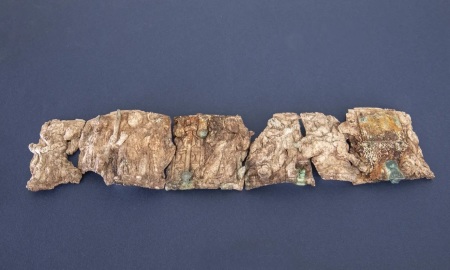Archaeologists uncover 1,500-year-old depiction of Moses receiving the Ten Commandments

Archaeologists have discovered a 1,500-year-old relic in southern Austria that they believe depicts Moses receiving the Ten Commandments and the Ascension of Jesus Christ.
During excavations of a church at the summit of Burgbichl, a small hill in the municipality of Irschen, archeologists from Innsbruck University of Austria uncovered a shrine containing a 1,500-year-old ivory box adorned with Christian motifs. The discovery was first made in August 2022.
The school said in a recent statement announcing the discovery that archaeologists have done excavations in Irschen, which is a part of the Carinthian Drava Valley, since 2016.
"We know of around 40 ivory boxes of this kind worldwide and, as far as I know, the last time one of these was found during excavations was around 100 years ago — the few pyxes that exist are either preserved in cathedral treasures or exhibited in museums," lead archaeologist Gerald Grabherr said.
One of the motifs shows a man turning his head with a hand rising out of the sky above him. He appears to also be placing something between the person's arms, along with depictions of biblical figures.
"This is the typical depiction of the handing over of the laws to Moses on Mount Sinai, the beginning of the covenant between God and man from the Old Testament," said Grabherr.
The final motif shows a man in a chariot with two horses attached to it with a harness and includes the same hand coming out of the clouds, pulling a figure up into Heaven.
"We assume that this is a depiction of the ascension of Christ, the fulfillment of the covenant with God," Grabherr stated.
"The depiction of scenes from the Old Testament and their connection with scenes from the New Testament is typical of late antiquity and thus fits in with our pyx; however, the depiction of the Ascension of Christ with a so-called biga, a two-horse chariot, is very special and previously unknown."
Researchers uncovered two Christian churches, a cistern and the personal belongings of the settlement's previous inhabitants.
At the end of the Roman Empire, settlers resided on hilltops that were easier to defend, abandoning the valley, Grabherr explained.
Researchers will investigate the origin of the ivory, the metallic components and the wooden parts that were also discovered in the marble box.
"The archaeological and art-historical significance of the pyx cannot be denied," said Grabherr.
Nicole VanDyke is a reporter for The Christian Post.






















